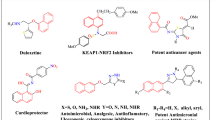Abstract
In an attempt to search for new natural product-based antitumor agents, a series of novel (aryl)methyl-amine derivatives of dehydroabietic acid-based B ring-fused-thiazole were designed and synthesized. The primary bioassay showed that compounds 5r and 5s presented certain inhibitory activity against cancer cells, weak cytotoxic activity against normal cells, and inhibitory activity against PI3K/AKT/mTOR signaling pathway. The binding modes and the binding site interactions between the active compounds and the target proteins were predicted preliminarily by the molecular docking method.
Graphic abstract






Similar content being viewed by others
References
Tanaka R, Tokuda H, Ezaki Y (2008) Cancer chemopreventive activity of “rosin” constituents of Pinus spez. and their derivatives in two-stage mouse skin carcinogenesis test. Phytomedicine 15:985–992. https://doi.org/10.1016/j.phymed.2008.02.020
Luo S, Jiang L, Wang Y (2015) Review on the structural modification of rosin’s active components. Nat Prod Res Dev 27:737–741
Cui Y, Rao X, Shang S, Song J (2012) Recent advances on biologic activity of dehydroabietic acid derivatives. Chem Ind For Prod 36:99–106
Gu W, Wang S (2010) Synthesis and antimicrobial activities of novel 1H-dibenzo[a, c]carbazoles from dehydroabietic acid. Eur J Med Chem 45:4692–4696. https://doi.org/10.1016/j.ejmech.2010.07.038
Fei BL, Tu SY, Wei ZZ, Wang PP, Qiao CH, Chen ZF (2019) Optically pure chiral copper(II) complexes of rosin derivative as attractive anticancer agents with potential anti-metastatic and anti-angiogenic activities. Eur J Med Chem 176:175–186. https://doi.org/10.1016/j.ejmech.2019.05.030
Chen N, Duan W, Lin G, Liu L, Zhang R, Li D (2016) Synthesis and antifungal activity of dehydroabietic acid-based 1,3,4-thiadiazole-thiazolidinone compounds. Mol Divers 20:897–905. https://doi.org/10.1007/s11030-016-9691-x
Fonseca T, Gigante B, Marques MM, Gilchrist TL, Clercq ED (2004) Synthesis and antiviral evaluation of benzimidazoles, quinoxalines and indoles from dehydroabietic acid. Bioorg Med Chem 12:103–112. https://doi.org/10.1016/j.bmc.2003.10.013
Kim E, Kang YG, Kim YJ, Lee TR, Yoo BC, Jo M, Kim JH, Kim JH, Kim D, Cho JY (2019) Dehydroabietic acid suppresses inflammatory response via suppression of Src-, Syk-, and TAK1-mediated pathways. Int J Mol Sci 20:E1593. https://doi.org/10.3390/ijms20071593
Vahermo M, Krogerus S, Nasereddin A, Kaiser M, Brun R, Jaffe CL, Yli-Kauhaluoma J, Moreira VM (2016) Antiprotozoal activity of dehydroabietic acid derivatives against Leishmania donovani and Trypanosoma cruzi. MedChemComm 7:457–463. https://doi.org/10.1039/c5md00498e
Kim J, Kang YG, Lee JY, Choi DH, Cho YU, Shin JM, Park JS, Lee JH, Kim WG, Seo DB, Lee TR, Miyamoto Y, No KT (2015) The natural phytochemical dehydroabietic acid is an anti-aging reagent that mediates the direct activation of SIRT1. Mol Cell Endocrinol 412:216–225. https://doi.org/10.1016/j.mce.2015.05.006
Cui YM, Liu XL, Zhang WM, Lin HX, Ohwada T, Ido K, Awada K (2016) The synthesis and BK channel-opening activity of N-acylaminoalkyloxime derivatives of dehydroabietic acid. Bioorg Med Chem Lett 26:283–287. https://doi.org/10.1016/j.bmcl.2015.12.038
Chen N, Duan W, Lin G, Liu L, Zhang R, Li D (2016) Synthesis and antifungal activity of dehydroabietic acid-based B ring-fused-thiazole-amide compounds. Fine Chem 33:811–819. https://doi.org/10.13550/j.jxhg.2016.07.016
Chhabria MT, Patel S, Modi P, Brahmkshatriya PS (2016) Thiazole: a review on chemistry, synthesis and therapeutic importance of its derivatives. Curr Top Med Chem 16:2841–2862. https://doi.org/10.2174/1568026616666160506130731
Majeed R, Hamid A, Qurishi Y, Qazi A, Hussain A, Ahmed M, Najar R, Bhat J, Saxena S (2012) Therapeutic targeting of cancer cell metabolism: role of metabolic enzymes, oncogenes and tumor suppressor genes. J Cancer Sci Ther 4:281–291. https://doi.org/10.4172/1948-5956.1000156
Sharmaa PC, Bansala KK, Sharmaa A, Sharmaa D, Deep A (2019) Thiazole-containing compounds as therapeutic targets for cancer therapy. Eur J Med Chem 188:112–116. https://doi.org/10.1016/j.ejmech.2019.112016
Peng QH, Duan WG, Xu XT, Fang HX, Shen CM (2007) Microwave-assisted extraction of dehydroabietic acid. Appl Chem Ind 36(860–862):868
Chen H, Xu F, Xu BB, Xu JY, Shao BH, Huang BY, Yuan M (2016) Design, synthesis and biological evaluation of novel arylpiperazine derivatives on human prostate cancer cell lines. Chin Chem Lett 27:277–282. https://doi.org/10.1016/j.cclet.2015.09.016
Rehan M, Bajouh OS (2018) Virtual screening of naphthoquinone analogs for potent inhibitors against the cancer-signaling PI3K/AKT/mTOR signaling pathway. J Cell Biochem 2018:1–12. https://doi.org/10.1002/jcb.27100
Lin G, Bai X, Duan W, Cen B, Huang M, Lu S (2019) High value-added application of sustainable natural forest product α-pinene: synthesis of myrtenal oxime esters as potential KARI inhibitors. ACS Sustain Chem Eng 7:7862–7868. https://doi.org/10.1021/acssuschemeng.9b00254
Acknowledgements
This research was supported by Guangxi Natural Science Foundation under Grant Nos. 2018GXNSFAA138023 and 2019GXNSFAA245057, the Guangxi Distinguished Professor Grant (2018), Youth Science Foundation of Guangxi Medical University (No. GXMUYSF201703), and Open Research Project from Key Laboratory of High Incidence Diseases Prevention and Control of Guangxi Universities and Colleges, No. 02402214003-1705.
Author information
Authors and Affiliations
Corresponding authors
Ethics declarations
Conflict of interest
The authors declare that they have no conflict of interest.
Additional information
Publisher's Note
Springer Nature remains neutral with regard to jurisdictional claims in published maps and institutional affiliations.
Electronic supplementary material
Below is the link to the electronic supplementary material.
Rights and permissions
About this article
Cite this article
Chen, NY., Xie, YL., Lu, GD. et al. Synthesis and antitumor evaluation of (aryl)methyl-amine derivatives of dehydroabietic acid-based B ring-fused-thiazole as potential PI3K/AKT/mTOR signaling pathway inhibitors. Mol Divers 25, 967–979 (2021). https://doi.org/10.1007/s11030-020-10081-7
Received:
Accepted:
Published:
Issue Date:
DOI: https://doi.org/10.1007/s11030-020-10081-7




